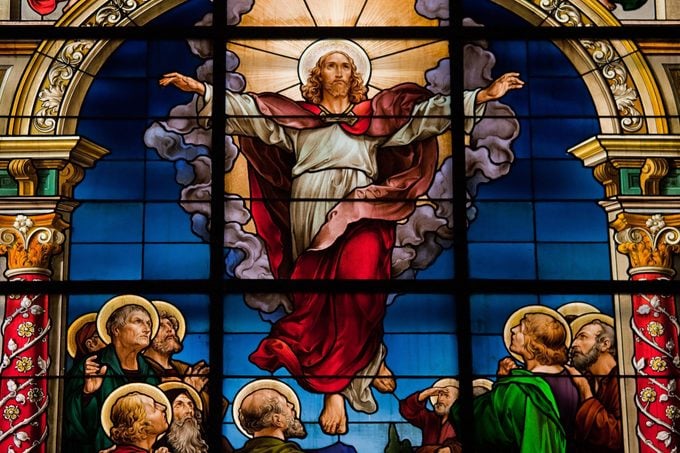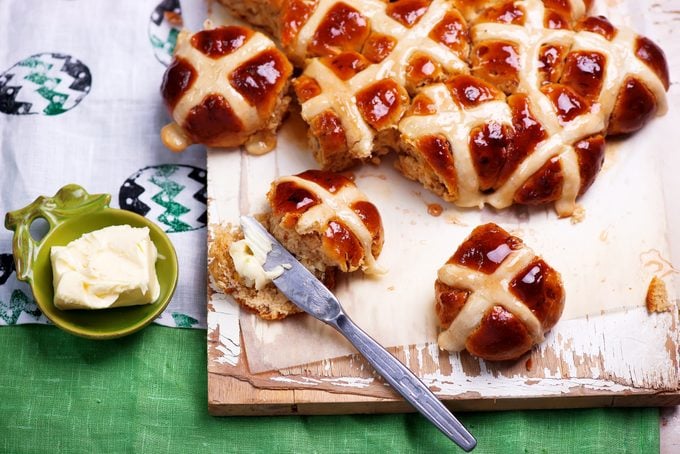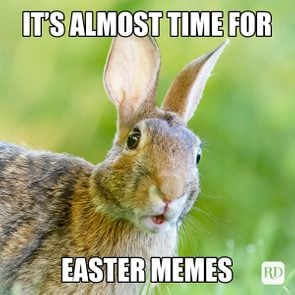What Is Easter, and Why Do We Celebrate It?
Updated: Apr. 06, 2024

What is Easter and how did this holiday begin? Here's what to know!
From the springtime setting with newly bloomed flowers to fun Easter traditions, like dyeing eggs and making creative Easter baskets, there’s a lot to love about Easter. It’s a holiday celebrated by many. In fact, according to a U.S. survey by Statista, 81% of respondents celebrated the holiday in 2023, and it consistently ranks in the top 10 of most popular holidays in the United States. But what is Easter all about?
Some celebrants might say it’s about candy-filled Easter eggs. (The little ones would agree.) But for many people, Easter is about religious observances and beliefs. So, before you look into what day Easter is or send those Easter wishes to loved ones, read up on the origins of the holiday as we know it.
Get Reader’s Digest’s Read Up newsletter for more holiday tips, fun facts, humor, cleaning, travel and tech all week long.
What is Easter?
Easter is a religious Christian holiday observed around the world to celebrate the resurrection of Jesus Christ, the spiritual leader of Christianity—and to Christians, the son of God. But with some aspects of the holiday rooted in pagan and Jewish traditions, the origin of Easter dates back to centuries before Christ was even born. These days, many people celebrate Easter, regardless of their religion.
Why do we celebrate Easter?

Easter celebrations are rooted in one of the world’s largest religions. According to the Bible, the Romans crucified Jesus, a popular Jewish preacher and religious leader many believed is the Son of God. Three days after he was entombed, he was resurrected from the grave, overcoming death, and through his sacrifice, he offered salvation to all humankind. So, what is Easter? In short, it’s a holiday celebrating this miracle.
When is Easter this year?
What day is Easter? Well, Easter falls on Sunday, March 31, 2024. While many other holidays have fixed dates (Christmas, for instance, is always on Dec. 25), Easter’s date changes from year to year. Determining the date is a little like working out an Easter riddle: What happens on the first Sunday following the full moon that occurs on or just after the spring equinox? Yep, that’s Easter.
Based on the cycles of the moon, the holiday might occur on any Sunday between March 22 and April 25. It can get confusing, so here’s a cheat sheet of Easter dates for the next five years:
- Sunday, April 20, 2025
- Sunday, April 5, 2026
- Sunday, March 28, 2027
- Sunday, April 16, 2028
- Sunday, April 1, 2029
What is the history of Easter?
The Christian celebration of Jesus’s resurrection may be the most familiar Easter tradition, but it’s certainly not the oldest. The holiday also has roots in paganism and Judaism.
Pagan Easter traditions
There is historical evidence of millennia-old spring celebrations centered around the equinox—early versions of May Day festivals. Because they occurred at the beginning of the planting season, many of these early pagan holidays used symbols of fertility, growth, birth, fortune and light conquering the dark. Many secular Easter traditions are handed down from these ancient rituals, including Easter baskets, flower crowns and egg hunts.
Even the holiday’s name has a pagan connection. Historians believe Easter was named after one of the more popular figures in these celebrations: the Anglo-Saxon goddess Eostre.
Christian Easter traditions

When early Christians were creating their calendar of holy days, it made sense to combine the celebration of Jesus’s resurrection with the traditional spring festival. So instead of centering on the pagan Eostre, the holiday’s religious history is all about Jesus Christ.
The popular Jewish preacher became a target of Jewish authorities after he claimed to be the long-awaited Messiah and Son of God. The Romans also saw him as a possible political problem. Jesus was tried and convicted of blasphemy by Jewish authorities and sentenced to execution. The Roman governor ordered his death in a brutal Roman style called crucifixion; Jesus was crowned with thorns and nailed to a cross until he died. After, his body was dressed and laid to rest in a stone tomb. Three days later, according to Christian doctrine, he was miraculously resurrected and returned to visit his disciples.
Easter serves as the foundation for many holy celebrations that lead up it, starting with Ash Wednesday (the first day of Lent), Lent (the observance of giving up something you love for 40 days in honor of Jesus’s 40-day fast in the desert), Palm Sunday (the day Jesus rode into Jerusalem and was celebrated as the Messiah) and Good Friday (the day Jesus was crucified).
Traditions like baking hot cross buns and filling empty eggs are symbolic of Christ’s death on the cross and resurrection from the tomb. Other traditions based on the Christian story include listening to performances of Handel’s Messiah and watching Easter movies, including The Passion of the Christ.
Jewish Easter traditions
Other religious Easter traditions come from the concurrent Jewish celebration of Passover, a commemoration of the Jews’ escape from slavery in Egypt. The Jewish holiday provides the basis for Easter feasts and many traditional Easter foods, including lamb.
Why is Easter called Easter?
Easter is an English word tied to the German word Ostern. Its origins are a bit mysterious, but people believe it comes from calling Easter week the Latin phrase, “in albis.” This phrase later turned into “eostarum” in Old High German. Historians also believe Easter was named after the goddess Eostre. Oh, and then there’s the French word for Easter, Pâques, which gets its groove from the Latin and Greek word, Pascha, meaning Passover.
Why do we celebrate Easter with eggs and bunnies?

Marking such a solemn holiday with a mascot like the Easter Bunny may not seem like the most logical choice. But it begins to make sense when you remember that Eostre is the goddess of fertility, and rabbits mate like, well, rabbits. Baby bunnies are everywhere in the springtime, a sign of fertility and, traditionally speaking, good luck.
The bunny that brings goodies for tweens, teens and little tykes is a relatively modern invention. The origin of the Easter Bunny dates back to the 1900s, when it appeared in advertising cartoons.
Its loot—whether candy-colored dyed eggs or those made from sweet chocolate—is a nod to both pagan and Christian traditions. Eggs represent new life, symbolizing not only the fertility of Eostre but also the rebirth of Christ after death.
Because the holiday is also a celebration of the season, aligning closely with the spring equinox, symbols of spring are incorporated into the festivities. After all, what is Easter without baby chicks, green grass and flowers in bloom?
How do I celebrate Easter?

Many people have their own favorite family Easter games and activities (like sharing adorable Easter puns) but there’s always room to add more fun. Let the little ones hunker down in front of an Easter movie for kids while the adults prep dinner. Get the whole group involved in playing Easter bingo. Or take part in one of the activities below.
Dye Easter eggs
Wax, glitter, stickers, markers and brightly colored dyes add whimsy and fun to hard-boiled eggs. Kids and adults alike can express their creative sides while making designs worthy of holiday decor.
Hunt for Easter eggs
Fill plastic eggs with candy and toys, then hide them outdoors for children to find on Easter morning. It’s a treasure hunt, a little exercise and a photo opportunity all in one.
Attend a church service
What is Easter all about? For Christians, it’s the resurrection of Christ after he died on the cross, so church is front and center in the celebration. Most Christian churches offer a special service on Easter morning. It’s tradition to wear your Sunday best while listening to a sermon and singing hymns.
Host Easter dinner
This is the perfect opportunity to gather your loved ones for a celebratory feast. A ham or lamb, potatoes, fresh vegetables, hot cross buns, deviled eggs, fruit salad and carrot cake are just some of the traditional Easter foods you’re likely to find on the table.
What are some Easter fun facts?

- Approximately 180 million eggs are purchased each year for Easter. They’re used for dyeing, hunts and Easter recipes.
- Surprisingly, 81% of parents steal candy from their kids’ Easter baskets.
- Cadbury makes 500 million Creme Eggs every year—more than 1.5 million per day, every single day.
- Chocolate bunnies are the most popular item to put in an Easter basket, and more than 78% of people say they eat the ears first.
- An impressive 60% of parents say they still send their adult kids an Easter basket, even after they’ve moved out.
- The largest chocolate egg ever created weighed 15,873 pounds—about the size of an elephant! The largest chocolate bunny was 9,360 pounds.
- There are more than 50 official flavors of Jelly Belly jelly beans, an Easter favorite, but the company is always trying out new flavors and releasing limited editions. This year, you can try Birthday Cake Remix and the Snapple Mix (though maybe not at the same time).
- Easter Sunday is the most popular day to attend church in America.
Why trust us
At Reader’s Digest, we’re committed to producing high-quality content by writers with expertise and experience in their field in consultation with relevant, qualified experts. We rely on reputable primary sources, including government and professional organizations and academic institutions as well as our writers’ personal experience where appropriate. We verify all facts and data, back them with credible sourcing, and revisit them over time to ensure they remain accurate and up to date. Read more about our team, our contributors and our editorial policies.
Sources:
- Farmer’s Almanac: “When Is Easter 2024? How Easter’s Date Is Determined”
- Statista: “Most popular national and religious events in the United States as of the 2nd quarter of 2023”
- Statista: “Do you celebrate Easter?”
- National Retail Federation: “Easter”
- Wallet Hub: “2023 Easter Facts & Stats: Church, Candy & Cash”
- The Guardian: “The Pagan Roots of Easter”



